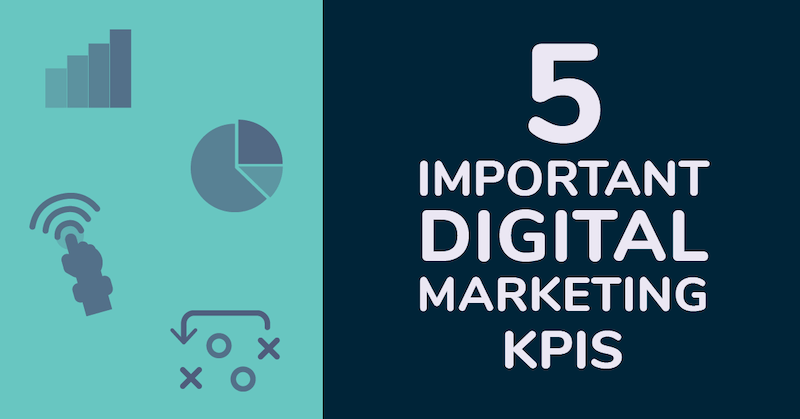5 Important Digital Marketing KPIs

With the abundance of information available to advertisers today, it’s essential to take an analytical approach to digital marketing campaigns. That’s where digital marketing KPIs come in.
Tracking performance is crucial to know which ads are performing well and which ones need a little TLC. Sales and leads are typical metrics of success but shouldn’t be the only benchmark to watch. Marketers track campaign success with KPIs.
KPI stands for Key Performance Indicator. These are quantifiable metrics that gauge business performance and digital marketing activities. The most relevant KPIs depend on your unique business goals. KPIs span over multiple tools and platforms. In digital marketing, these usually include a combination of social media, PPC tools (Google Ads) web analytics tools (Google Analytics), and lead conversion tools (websites).
- Lead generation KPIs
- Brand awareness KPIs
- Sales growth KPIs
- Search engine optimization (SEO) KPIs
And so forth.
In this article, we are defining 5 common digital marketing KPIs, how they are calculated, and how they can be optimized for success.
The importance of setting goals
Before we enter the world of digital marketing KPIs, we need to reiterate the importance of goal setting. Goals are the foundation of every good marketing campaign. Without goals, you don’t know what you’re trying to achieve, and won’t be able to measure your campaign’s success and performance accurately. Simply put, if you don’t have a goal, you won’t have a KPI. If you need some direction with goal setting or even a quick refresher, check out MPP’s comprehensive article on how to set SMART Goals.
The ease of tracking digital marketing KPIs can be overwhelming. There are a lot of numbers to look at. This makes it easy to track important metrics, but also makes it easy to get distracted by metrics that have no value. Remember: stick to your goals.
For example, it’s tempting to track vanity metrics like your Facebook likes and followers. But, if you’re not running a social media campaign with the goal of getting more likes or followers, why track it?

5 important digital marketing KPIs to track
As we mentioned, the KPIs you create are unique to your business and should align with your goals. There are a ton of different KPIs – too many to list in this article. Our intention is not to overwhelm you with options, but to give you an idea of the kinds of KPIs you or your marketing partners can use to gauge the success of your campaigns.
Conversions/Conversion Rate
Conversion rate is the number of visitors that take a desired action. This can mean that they:
- downloaded your eBook
- signed up for your newsletter
- filled out an inquiry form on your website
- renewed a subscription
- and more
-
To calculate Conversion Rate:
Divide the number of visitors that complete a desired action compared to the total number of visitors.
For example, if 100 visitors come to a website and 10 purchase a product, that’s a 10% conversion rate.
Conversion rates show how relevant your content is to your audience. If your conversion rate is low, there’s a disconnect between your ad and your audience. Maybe it’s a sign to optimize the campaign by tweaking your messaging or landing page.
This is also a good time to analyze your marketing funnels. These are steps visitors take to convert. Pay attention to customer profiles, traffic sources, and content that leads to the most conversions.
Click-Through Rate (CTR)
CTR relates to marketing efforts intended to get customers to click on your website. Display ads, search results, and social are a few examples of marketing that involve click-through rate (CTR).
To calculate Click-Through Rate:
Divide the number of clicks that your ad receives by the number of times your ad is shown.
A high average CTR shows your ad is drawing attention and traffic to your site. If more people click through your ad, that results in more traffic and, hopefully, more revenue.
You can track which activity drives more visitors to your site by using unique links for different campaigns. For example, Google AdWords ads will have a CTR that lets you know how many clicks to your site a particular ad is driving.
Every channel and industry have different benchmark CTRs. There is no magical benchmark number across the board. In social advertising, Twitter ads have the highest CTR (2.00%) and LinkedIn has the lowest (0.06%). Factors such as how people use the network and the type of ad (video vs link) impact this number.
When looking at CTR, see where traffic is coming from and invest your time and energy in the channels that perform the best. If performance isn’t where you want it to be, consider tweaking the landing pages, copy, or ad creative to see if there is an improvement.
Bounce Rate
Another important KPI to consider looking at alongside CTR is the bounce rate. A bounce is when someone lands on your site then leaves from that same page. A bounce is like walking into a store and immediately walking out without looking around or finding what you need. As a marketer, a bounce shows the ad was intriguing enough to click on, but the visitor wasn’t engaged enough to stay.
To calculate Bounce Rate:
Take the number of website visits where only one page was viewed in a period of time and divide that by the total number of website visits in the same time period.
If you have a high bounce rate, it’s likely that customers don’t trust or find value in the content they have found. Inspect elements that could be causing this disconnect, such as web copy or audience targeting. If you have a low bounce rate, it’s an indication that visitors are finding what they need. Study how you can replicate its performance for future campaigns.
Cost Per Click (CPC)
While it’s important to track conversions, how much you spend to generate conversions is equally important. CPC is primarily found in pay-per-click (PPC) advertising campaigns (such as Google AdWords) and refers to the cost an advertiser pays each time a user clicks on their digital ad. You will not pay if an impression was served but not clicked on.
To calculate Cost Per Click:
Divide the total cost of your clicks by the total number of clicks.
For example:
Cost of advertising: $500
Number of clicks: 625 clicks
Divide the cost by the number of clicks: $500/625 clicks
Your Cost Per Click (CPC) is $0.80
If the keywords you’re bidding on are too expensive and you don’t have the budget to own that space, bid on keywords that have lower competition. You can also optimize your ad assets. Ensure that landing pages drive action and are unique for each PPC offer, CTAs are clear, and headlines are short and impactful. If your strategy is effective, CPC will decrease every month.
If you’re finding out that PPC isn’t working out for you, investing time and energy in SEO may be more lucrative. We go over the differences between SEO and PPC in this article. There’s no cost to appear in organic search results. Making changes to improve your website’s SEO can impact your search rankings over time.
ROI
ROI (Return on Investment) is an indicator you can measure for all your marketing campaigns. By tracking ROI you’ll determine whether the net income is worth the money you spend.
To calculate ROI:
(Gain from Investment – Cost of Investment) / Cost of Investment.
To track and measure ROI, you need to know how much you’re spending on marketing. If you have multiple marketing channels working at the same time, you’ll need to track each one individually to determine their ROI.
Depending on your company and industry, ROIs can differ greatly. It’s common for this number to be negative when you start out. However, with a successful strategy, you’ll see a positive impact within several months.
Ready to start tracking digital marketing KPIs?
Now you know 5 common KPIs that businesses and marketers track for success. Before your campaign goes live, ask yourself: what is the goal of my ads? Do I have tools in place to track success and KPIs established that align with your goals? KPIs are important and the ones we’ve gone over are just a few that every marketer can track and improve to grow their business faster. If you’re not seeing the results you’d like, consider optimizing the KPIs we mapped out today and use them to scale your brand.


